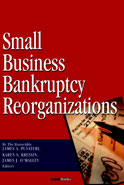|
|
|
|
||||||

|
Small Business Bankruptcy Reorganizations
By James A. Pusateri, Karen Kressin, and James J. O'Malley 2005/07 - Beard Books 1587982609 - Paperback - Reprint - 664 pp. US$34.95 Twenty-three practitioners in the field of business bankruptcy share their expertise for both sides of a bankruptcy. Publisher Comments This well-documented book written by twenty-three expert practitioners is comprised of a collection of informative chapters on topics of interest to either side of a small business bankruptcy reorganization. Among others, the book covers general and specific issues related to cash collateral, relief from automatic stay, creditor strategies, valuation of property, avoiding powers, partnership bankruptcies, disclosure statement strategies, reorganization plan drafting, confirmation, and the absolute priority rule. Forms and sample documents are included to bolster its use as a practice guide. This illuminating work will prove informative for small businesspersons as well as professionals in the field of bankruptcy. From a previous edition: Renowned practitioners and judges offer commentary on the unique aspects of this burgeoning area of bankruptcy practice. This superlative resource anticipates the enactment of proposed amendments to the Bankruptcy Code which would create procedures to handle small business reorganizations. Covers a wide range of issues vital to small businesses including ERISA, postpetition financing and capital gains taxes. From Turnarounds and Workouts, January 15, 2006 Small Business Bankruptcy Reorganization, first published in 1994, covers most of the pertinent issues for parties on both sides of a bankruptcy proceeding-namely, business owners and creditors. Anyone involved in a small business bankruptcy in any capacity will find this book to be especially useful. Each chapter is written by a different author with extensive experience in bankruptcy proceedings. The authors are heavily concentrated in the Midwest, the state of Kansas in particular, and the three coeditors have all been involved in the Kansas legal and court systems with respect to bankruptcies. For most readers, the work is not one they will read through from beginning to end. Rather, it is an estimable reference that small businesspersons or creditors can tap for answers and counsel on legal steps, paperwork, and decisionmaking. The various issues involved in a bankruptcy are not simply generalized, but the book's multiple authors reflect an understanding that every bankruptcy involves circumstances specific to the particular business, its owners, and the types of creditors involved. Each of these components has to be carefully examined in order for the bankruptcy to progress smoothly to an acceptable outcome for all constituencies. The editors and authors understand the variables and, in some cases, the unprecedented factors that arise in small business bankruptcies. As the book instructs, a small business bankruptcy can present special problems and does not "always comport with the vision of the drafters of Chapter 11 of the Bankruptcy Code." That is, while all bankruptcy legal proceedings call for certain financial information to be disclosed and for a methodical legal process to be followed, the variables of each case are innumerable. These variables make all the difference in the outcome of a bankruptcy, and it is crucial for the parties to know about them. The value of this book is in providing such knowledge for small businesspersons and creditors looking to pursue a bankruptcy proceeding as economically as possible. In Small Business Bankruptcy Reorganization, both small business
debtors and creditors have access to the substantive, pertinent legalities
entailed in bankruptcy, along with related commentary and advice. The book also
offers a detailed table of contents listing the subsections of the chapters and
a detailed index where the reader can readily find a specific topic. James A. Pusateri is a former Chief Judge of the United States Bankruptcy Court for the District of Kansas, and a founding member of the Bankruptcy Appellate Panel of the Tenth Circuit. He has also taught at Washburn Law School. Karen Kressin is an attorney licensed in Kansas and Colorado who has worked as a clerk for Judge Pusateri. James J. O'Malley is also an attorney who has been a clerk for judges of higher courts in Kansas. The Honorable James A. Pusateri recently retired after 26 years on the bankruptcy bench. Judge Pusateri served on the Board of Governors of the National Conference of Bankruptcy Judges, was Chief Judge of the United States Bankruptcy Court for the District of Kansas, a founding member of the Bankruptcy Appellate Panel of the Tenth Circuit, and an Adjunct Professor at Washburn Law School. Karen Kressin is an attorney licensed to practice in Kansas and Colorado. A summa cum laude graduate of Georgetown University, she earned her law degree at the University of Kansas, where she served as technical editor of the Kansas Law Review. She was a law clerk for the late J. Richard Foth, Chief Judge of the Kansas Court of Appeals, for Justice Fred N. Six of the Kansas Supreme Court, and for United States Bankruptcy Judge James A. Pusateri. James J. O'Malley is an editor at Allen Press, Inc., a publisher of scientific, technical and medical journals. A summa cum laude graduate of Bates College, he earned his law degree for the University of Kansas. Subsequently, he was a law clerk for Judge Mary Beck Briscoe of the Kansas Court of Appeals and the United States Court of Appeals for the Tenth Circuit and for United States Bankruptcy Judge James A. Pusateri. He was admitted to the bar in Kansas and Colorado.
|
|
|
|
home
| about us
| contact us
| related
sites |